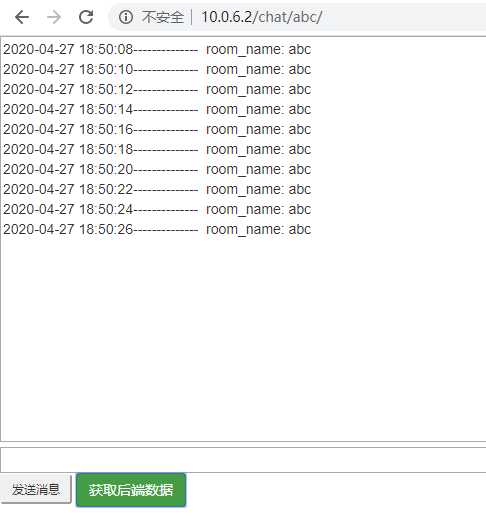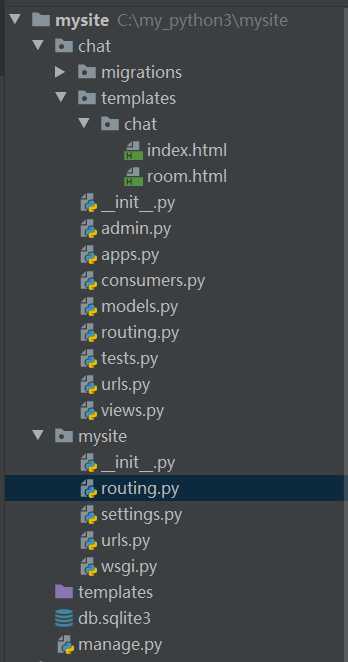标签:demo int config imp get 注意 pip3 inpu 添加
先来看一下最终的效果吧

开始聊天,输入消息并点击发送消息就可以开始聊天了

点击 “获取后端数据”开启实时推送

Channels是一个采用Django并将其功能扩展到HTTP以外的项目,以处理WebSocket,聊天协议,IoT协议等。它基于称为ASGI的Python规范构建。
它以Django的核心为基础,并在其下面分层了一个完全异步的层,以同步模式运行Django本身,但异步处理了连接和套接字,并提供了以两种方式编写的选择,从而实现了这一点。
详情请参考官方文档:https://channels.readthedocs.io/en/latest/introduction.html
ASGI 由 Django 团队提出,为了解决在一个网络框架里(如 Django)同时处理 HTTP、HTTP2、WebSocket 协议。为此,Django 团队开发了 Django Channels 插件,为 Django 带来了 ASGI 能力。
在 ASGI 中,将一个网络请求划分成三个处理层面,最前面的一层,interface server(协议处理服务器),负责对请求协议进行解析,并将不同的协议分发到不同的 Channel(频道);频道属于第二层,通常可以是一个队列系统。频道绑定了第三层的 Consumer(消费者)。
详情请参考官方文档: https://channels.readthedocs.io/en/latest/asgi.html
下边来说一下具体的实现步骤
转载请注明原文链接: https://www.cnblogs.com/Sunzz/p/12788608.html
pip3 install channels pip3 install channels_redis
django-admin startproject mysite
python3 manage.py startapp chat
mysite/settings.py文件#注册应用 INSTALLED_APPS = [ .... ‘chat.apps.ChatConfig‘, "channels", ]
# 在文件尾部新增如下配置
#将ASGI_APPLICATION设置设置为指向该路由对象作为您的根应用程序: ASGI_APPLICATION = ‘mysite.routing.application‘ #配置Redis CHANNEL_LAYERS = { ‘default‘: { ‘BACKEND‘: ‘channels_redis.core.RedisChannelLayer‘, ‘CONFIG‘: { "hosts": [(‘10.0.6.29‘, 6379)], }, }, }
在chat目录中创建一个templates目录。在您刚刚创建的templates 目录中,创建另一个名为的目录 chat,并在其中创建一个名为的文件index.html以保存索引视图的模板
将以下代码放入chat/templates/chat/index.html
<!-- chat/templates/chat/index.html --> <!DOCTYPE html> <html> <head> <meta charset="utf-8"/> <title>Chat Rooms</title> </head> <body> What chat room would you like to enter?<br> <input id="room-name-input" type="text" size="100"><br> <input id="room-name-submit" type="button" value="Enter"> <script> document.querySelector(‘#room-name-input‘).focus(); document.querySelector(‘#room-name-input‘).onkeyup = function(e) { if (e.keyCode === 13) { // enter, return document.querySelector(‘#room-name-submit‘).click(); } }; document.querySelector(‘#room-name-submit‘).onclick = function(e) { var roomName = document.querySelector(‘#room-name-input‘).value; window.location.pathname = ‘/chat/‘ + roomName + ‘/‘; }; </script> </body> </html>
chat/templates/chat/room.html
<!DOCTYPE html> <html> <head> <script src="https://cdn.bootcdn.net/ajax/libs/jquery/3.5.0/jquery.min.js" type="text/javascript"></script> <link rel="stylesheet" href="https://cdn.jsdelivr.net/npm/bootstrap@3.3.7/dist/css/bootstrap.min.css"> <script src="https://cdn.jsdelivr.net/npm/bootstrap@3.3.7/dist/js/bootstrap.min.js"></script> <meta charset="utf-8"/> <title>Chat Room</title> </head> <body> <textarea id="chat-log" cols="150" rows="30" class="text"></textarea><br> <input id="chat-message-input" type="text" size="150"><br> <input id="chat-message-submit" type="button" value="发送消息" class="input-sm"> <button id="get_data" class="btn btn-success">获取后端数据</button> {{ room_name|json_script:"room-name" }} <script> $("#get_data").click(function () { $.ajax({ url: "{% url ‘push‘ %}", type: "GET", data: { "room": "{{ room_name }}", "csrfmiddlewaretoken": "{{ csrf_token }}" }, }) }); const roomName = JSON.parse(document.getElementById(‘room-name‘).textContent); const chatSocket = new WebSocket( ‘ws://‘ + window.location.host + ‘/ws/chat/‘ + roomName + ‘/‘ ); let chatSocketa = new WebSocket( "ws://" + window.location.host + "/ws/push/" + roomName ); chatSocket.onmessage = function (e) { const data = JSON.parse(e.data); // data 为收到后端发来的数据 //console.log(data); document.querySelector(‘#chat-log‘).value += (data.message + ‘\n‘); }; chatSocketa.onmessage = function (e) { let data = JSON.parse(e.data); //let message = data["message"]; document.querySelector("#chat-log").value += (data.message + "\n"); }; chatSocket.onclose = function (e) { console.error(‘Chat socket closed unexpectedly‘); }; chatSocketa.onclose = function (e) { console.error("Chat socket closed unexpectedly"); }; document.querySelector(‘#chat-message-input‘).focus(); document.querySelector(‘#chat-message-input‘).onkeyup = function (e) { if (e.keyCode === 13) { // enter, return document.querySelector(‘#chat-message-submit‘).click(); } }; document.querySelector(‘#chat-message-submit‘).onclick = function (e) { const messageInputDom = document.querySelector(‘#chat-message-input‘); const message = messageInputDom.value; chatSocket.send(JSON.stringify({ ‘message‘: message })); messageInputDom.value = ‘‘; }; </script> </body> </html>
将以下代码放入chat/views.py
# chat/views.py
from django.shortcuts import render from django.http import JsonResponse from channels.layers import get_channel_layer from asgiref.sync import async_to_sync def index(request): return render(request, "chat/index.html") def room(request, room_name): return render(request, "chat/room.html", {"room_name": room_name}) def pushRedis(request): room = request.GET.get("room") print(room) def push(msg): channel_layer = get_channel_layer() async_to_sync(channel_layer.group_send)( room, {"type": "push.message", "message": msg, "room_name": room} ) push("推送测试", ) return JsonResponse({"1": 1})
在chat目录下创建一个名为的文件urls.py
# mysite/chat/urls.py from django.urls import path from . import views urlpatterns = [ path(‘‘, views.index, name=‘index‘),
path(‘<str:room_name>/‘, views.room, name=‘room‘),
]
# mysite/urls.py
from django.contrib import admin from django.urls import path, include from chat.views import pushRedis urlpatterns = [ path(‘admin/‘, admin.site.urls), path("chat/", include("chat.urls")), path("push", pushRedis, name="push"), ]
文件chat/consumers.py
当Django接受HTTP请求时,它会查询根URLconf来查找视图函数,然后调用该视图函数来处理该请求。同样,当Channels接受WebSocket连接时,它会查询根路由配置以查找使用者,然后在使用者上调用各种功能来处理来自连接的事件。
import time import json from channels.generic.websocket import WebsocketConsumer, AsyncWebsocketConsumer from asgiref.sync import async_to_sync import redis pool = redis.ConnectionPool( host="10.0.6.29", port=6379, max_connections=10, decode_response=True, ) conn = redis.Redis(connection_pool=pool, decode_responses=True) class ChatConsumer(AsyncWebsocketConsumer): async def connect(self, ): self.room_name = self.scope["url_route"]["kwargs"]["room_name"] self.room_group_name = "chat_%s" % self.room_name await self.channel_layer.group_add( self.room_group_name, self.channel_name, ) await self.accept() async def disconnect(self, close_code): print("close_code: ", close_code) await self.channel_layer.group_discard( self.room_group_name, self.channel_name ) async def receive(self, text_data=None, bytes_data=None): text_data_json = json.loads(text_data) message = text_data_json["message"] print("receive_message:", message) await self.channel_layer.group_send( self.room_group_name, { "type": "chat_message", "message": message } ) async def chat_message(self, event): receive_message = event["message"] response_message = "You message is :" + receive_message await self.send(text_data=json.dumps({ "message": response_message })) class PushMessage(WebsocketConsumer): def connect(self): self.room_group_name = self.scope["url_route"]["kwargs"]["room_name"] async_to_sync(self.channel_layer.group_add)( self.room_group_name, self.channel_name ) self.accept() def disconnect(self, code): async_to_sync(self.channel_layer.group_discard)( self.room_group_name, self.channel_name ) def push_message(self, event): """ 主动推送 :param event: :return: """ print(event, type(event)) while True: time.sleep(2) msg = time.strftime("%Y-%m-%d %H:%M:%S") + "--- room_name: %s" % event["room_name"] self.send(text_data=json.dumps( {"message": msg} ))
在chat目录下创建一个名为的文件routing.py
# mysite/chat/routing.py from django.urls import re_path, path from . import consumers websocket_urlpatterns = [ re_path(r"ws/chat/(?P<room_name>\w+)/$", consumers.ChatConsumer), path("ws/push/<room_name>", consumers.PushMessage), ]
与setting同级目录新建ws根路由文件 routing.py
from channels.routing import ProtocolTypeRouter, URLRouter from channels.auth import AuthMiddlewareStack import chat.routing application = ProtocolTypeRouter({ "websocket": AuthMiddlewareStack( URLRouter( chat.routing.websocket_urlpatterns ) ), })

python3 manage.py runserver 10.0.6.2:80
注意看,这和django是不一样的

还有另一种更稳健的启动方式
和setting同级新增文件 asgi.py
import os import django from channels.routing import get_default_application os.environ.setdefault("DJANGO_SETTINGS_MODULE", "mysite.settings") django.setup() application = get_default_application()
启动方式为:
daphne -b 10.0.6.2 -p 80 mysite.asgi:application
daphne 在安装channel时已经自动安装好了

参考:
https://channels.readthedocs.io/en/latest/tutorial/index.html
https://blog.ernest.me/post/asgi-demonstration-realtime-blogging
标签:demo int config imp get 注意 pip3 inpu 添加
原文地址:https://www.cnblogs.com/Sunzz/p/12788608.html